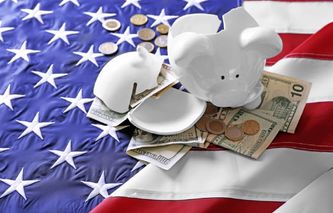They say that holidays are about family, love, and togetherness. They are meant to help us remember and celebrate events of traditional and cultural significance. However, according to these holiday spending statistics, holidays are a tad more artificial than that. The spending of US consumers during holidays is slowly approaching the $1 trillion mark, and it is safe to say that it is starting to get out of control.
There is little moderation when it comes to buying gifts, clothes and accessories, costumes, food and drinks and other holiday gifts. If you want to learn more about this excessive behavior, check out the stats on holiday spending in the article below.
Top 10 Holiday Spending Statistics and Facts
The average consumer spent $1,463 on holiday shopping in 2021.
11.5% of Americans didn’t plan on spending anything in the 2021 holiday season.
77% of holiday shoppers say they will buy clothes and accessories this season.
The total expected spending on gift cards for the 2021 holiday season was $28.1 billion.
With an estimated average of $997.73 in 2021, Americans spend the most on the winter holidays.
96% of Americans said they would buy Christmas gifts for their family in 2021.
84% of Americans planned on celebrating Mother’s Day in 2022.
The total estimated spending for Easter 2022 was $20.8 billion.
Only 53% of Americans are planning on celebrating Valentine’s Day.
US consumers are expected to spend $10.1 billion on Halloween.
General Holiday Spending Statistics
The average consumer was estimated to spend $1,463 on holiday shopping in 2021.
The above figure is a 5% increase from the estimations made for 2020, when consumers were expected to spend an average of $1,387 on holiday shopping. What is also different in 2021 is that consumers are expected to spend the biggest portion of their money, or $536, on experiences, rather than on gifts like in 2020. The estimated budget for gifts in 2021 was $501, while an average of $426 was the estimated spending for non-gift purchases.
(Deloitte)
Consumers with an annual income of over $100,000 are expected to spend $2,624, on average.
Holiday shopping statistics show that the highest earners were expected to spend 15% more than the average of $2,279 they spent in 2020. On the other hand, consumers with yearly earnings of up to $50,000 were estimated to spend $536 on average, which was a 22% decrease from 2020 when they had spent $688. The data suggest a small increase in holiday spending for consumers in the $50,000 to $99,000 range. Their average expected holiday shopping for 2021 was $1,187, while it was $1,152 in 2020.
(Deloitte)
11.5% of Americans planned on not spending anything in the 2021 holiday season.
The holiday statistics also reveal that a considerable portion of consumers planned on sitting the 2021 season out. The largest share of consumers, or 65%, who would not spend anything in the 2021 holiday season were from the low-income group, with annual earnings of up to $50,000, while 23% were from the middle ($50,000 to $99,000) and 12% were high earners (over $100,000).
(Deloitte)
77% of holiday shoppers say they will buy clothes and accessories in the 2022 holiday season.
In addition, clothes and accessories is also the category where the highest average spending is expected, with $304. Moreover, holiday shopping trends show that 76% of consumers report planning to buy gift cards, and just as many say they will spend money on toys and hobbies. However, the average expected spending on gift cards is significantly higher at $235 than the $187 expected to be spent on toys and hobbies.
Furthermore, 66% of holiday shoppers plan on spending money on food and beverage, while 61% say they will purchase electronics. The expected average spent on food and drinks is $220, and $243 on electronics.
(Deloitte)
56% of Americans say they would like to receive holiday gift cards.
According to the latest holidays statistics, the wishlists of US consumers did not change too much from 2020, when gift cards were also the most commonly favored present by 54% of them. Clothes and accessories are the second most preferred gift, cited by 47% of Americans in both years. Books and other media have fallen off by 2% in 2021, and now they are favored by 32% of consumers, while electronics have dropped by 1% to 26%.
(NRF)
The total expected spending on gift cards for the 2021 holiday season is $28.1 billion.
Moreover, gift giving statistics reveal that the average consumer will purchase 3.4 gift cards and put an average amount of $48.92 in them. Restaurant gift cards are the most popular choice this year, with 32% of the consumers planning to buy them. An equal share of 26% of Americans plan on purchasing department store and bank-issued gift cards, while 20% say they will get coffee shop gift cards. Furthermore, 15% of consumers intend on getting entertainment and online merchant gift cards, 13% grocery store gift cards, and 12% gift cards for an electronics store.
(NRF)
Holidays Ranked by Spending
With an estimated average of $997.73 in 2021, Americans spend the most on the winter holidays.
The winter holiday season is by far the most expensive for US consumers. Mother’s Day is in the distant second place with an average spending of $220.48, while Easter is in third with $179.70. Furthermore, the average American is expected to spend $174.10 on Father’s Day, $164.76 on Valentine’s Day, and $102.74 on Halloween shopping. The estimated spendings for Independence Day and St Patrick’s Day are significantly lower at $80.54 and $40.77.
(NRF)
96% of Americans said they would buy Christmas gifts for their family in 2021.
The average Christmas budget of US consumers in 2021 allocated $648 for presents, $231 for non-gift purchases, like drinks and decorations, and $118 for other non-gift purchases. Men were expected to spend more, with an average of $1,046.38, while the estimated spending for women was $952.03. By age, consumers between 45 and 54 were expected to spend the most, or $1,161.98, followed by those aged between 35 and 44 with $1,083.74. The youngest Americans, aged between 18 and 24, were only expected to spend an average of $649.81.
(NRF)
84% of Americans planned on celebrating Mother’s Day in 2022.
If you were wondering where does Mother's Day rank in terms of most popular holidays, it is up there, just below the winter holidays. Additionally, the most recent data suggests that the estimated per-person average spending for Mother’s Day in 2022 was expected to increase from the year before, to $245.76. As a result, the total estimated spending for Mother’s Day in 2022 was expected to jump to $31.7 billion, which is $3.6 billion more than in 2021. Furthermore, statistics show that greeting cards are the most popular Mother’s Day gift, cited by 75% of consumers, followed by flowers and special outings, cited by 72% and 57% of consumers.
(NRF)
The total estimated spending for Easter 2022 was $20.8 billion.
Easter candy sales statistics reveal that 90% of the consumers planned on spending on candy this year, making it the most popular purchase around this holiday. Furthermore, 88% of Americans intended to spend on food, 63% on gifts, 49% on clothing, and 48% on decorations. The data suggests that households with children are expected to spend more in every single purchase category than those without any kids. For example, households with children are expected to spend an average of $46 on gifts, while those without children are expected to spend $20.
(NRF)
Americans were expected to spend $20 billion on Father’s day gifts in 2022.
The Father’s Day holiday spending in 2022 was expected to be very similar to the one in 2021, when it reached a record high of $20.1 billion. However, the average per-person spending was estimated to drop slightly, to $171.59 in 2022. The most common gifts that consumers purchase for Father’s Day include greeting cards, clothing items, and special outings, selected by 58%, 50%, and 48% of the holiday shoppers. Lastly, the data suggests that Father’s Day is notably less popular than Mother’s Day, as 76% of Americans reported tehy had plans for celebrating it.
(NRF)
Only 53% of Americans were planning on celebrating Valentine’s Day.
While it is often regarded as one of the most expensive holidays in the US, almost half of the US population had no intention of celebrating Valentine’s Day in 2022. However, the most interesting piece of information about spending on this holiday can be found in the demographics section of the stats, more specifically the gender data.
While a larger percentage of women (55% vs 52%) planned on celebrating it, men were expected to spend twice as much, or $235 vs $119. Furthermore, the data reveals that candy is the most popular Valentine’s Day gift, with 56% of the consumer saying they plan on giving it, while only 22% plan on buying jewelry.
(NRF)
US consumers are expected to spend $10.1 billion on Halloween.
Halloween spending statistics reveal that most of that money, or $3.3 billion, will be spent on Halloween costumes, and $1.49 billion of those will be spent on costumes for the grownups. Additionally, Americans are expected to spend $3.2 billion on decoration, $3 billion on candy, and $700 million on greeting cards.
Even though 65% of Americans say they plan on celebrating Halloween, 66% say they will hand out candy to trick-or-treaters. Moreover, 52% intend to decorate their yard, 46% to dress up, and 25% to throw or attend a party.
(NRF)
26% of Americans who celebrated Independence Day planned on buying patriotic items.
Holiday spending statistics show that the expected average spending for Independence Day was estimated to increase to $84.12 per person in 2022. It is one of the more popular holidays in the US, with 84% of Americans saying they planned to celebrate it in 2022 and spend an estimated total of $7.7 billion.
(NRF)
The average American was estimated to spend $42.33 on St. Patrick’s Day-related items in 2022.
Just over half, or 54%, of the US adult population, say they planned on celebrating St. Patrick’s Day in 2022, and they expected to spend $5.87 billion on this holiday. According to holiday spending statistics, this is the lowest amount on the holidays-by-spending list, but still $730 million more than 2021’s estimations.
(NRF)
Holiday Spending FAQs
How much money is spent during the holidays?
How much does the average consumer spend on holiday gifts?
What is the most commercially successful holiday?
Conclusion
Ultimately, we all love nice things, and gifts make us all happy. But do we really need to spend close to $1,000 to celebrate Christmas? At one point, we will have to admit that the commercialization of the winter holiday season has gotten out of hand and realize that the most beloved holidays don’t have to be the most expensive holidays in the US as well.
Sources:


.jpg)


